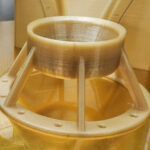A joint research project has just revealed the capabilities of electrically conductive PEEK 3D printer filament. The researchers produced the material by adding carbon nanotubes and graphite nanoplates, incorporating carbon-based electrical conductivity as opposed to metal. The filament presents a major leap forward, opening up new avenues in creating complex, functional structures.
The research was a joint project between University of Minho in Portugal, the Leibniz Institute of Polymer Research Dresden, and the Netherlands-based European Space Research and Technology Centre. The paper they published discusses the production of 1.75 mm electrically conductive PEEK filaments through the use of melt compounding and plasticating extrusion methods.
The graphite nanoparticles improved the PEEK’s melting properties, maintained the electrical conductivity at target level and reduced the coefficient of friction by up to 60%. Print tests showed an ultimate tensile strength comparable to those of the filaments, but a lower strain at break and electrical conductivity. This was due to of large voids in the part, solvable through 3D printing parameter optimization.
Electrically Conductive Thermoplastic
The team employed the use of PEEK materials from Victrex, a company specialising in high-performance, high-heat thermoplastics. They used pellets of PEEK and melted them down adding the multi-walled carbon nanotubes and the graphite. They then, re-pelletised this construct and transformed it into printable 1.75 mm filaments.
Former research into carbon nanotubes also played a role in moving towards an electrically conductive solution. Research into the morphology of carbon nanotubes between graphene nanoplates to form bridges developed filament with good properties. However, these had a far less effective electrical network. Thus, the team decided to prepare hybrid/ternary nanocomposites of PEEK/CNT/GnP with different compositions, using melt mixing, and measure their electrical conductivity.
The researchers extruded selected nanocomposites into the filaments. These filaments became the basis for manufacturing tensile bars using a commercial 3D printer. Although, it’s worth noting that every step of processing produced composites with lower electrical conductivity. However, they still maintained a sufficient level of conductivity (10 S/m) in the end. The European Research Agency tested these filaments in their satellites program.
Featured image courtesy of study co-authors. The full study is available here.











